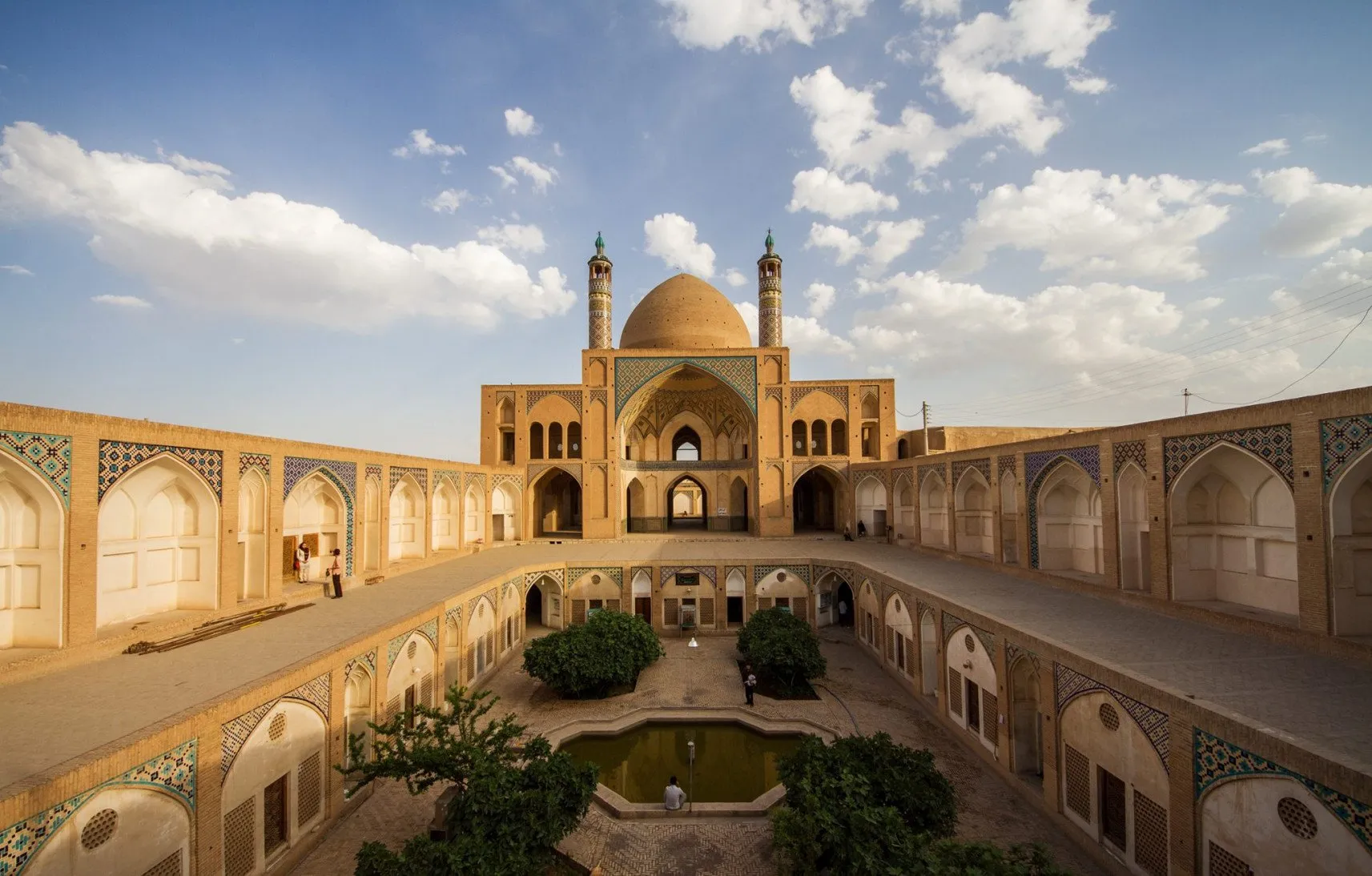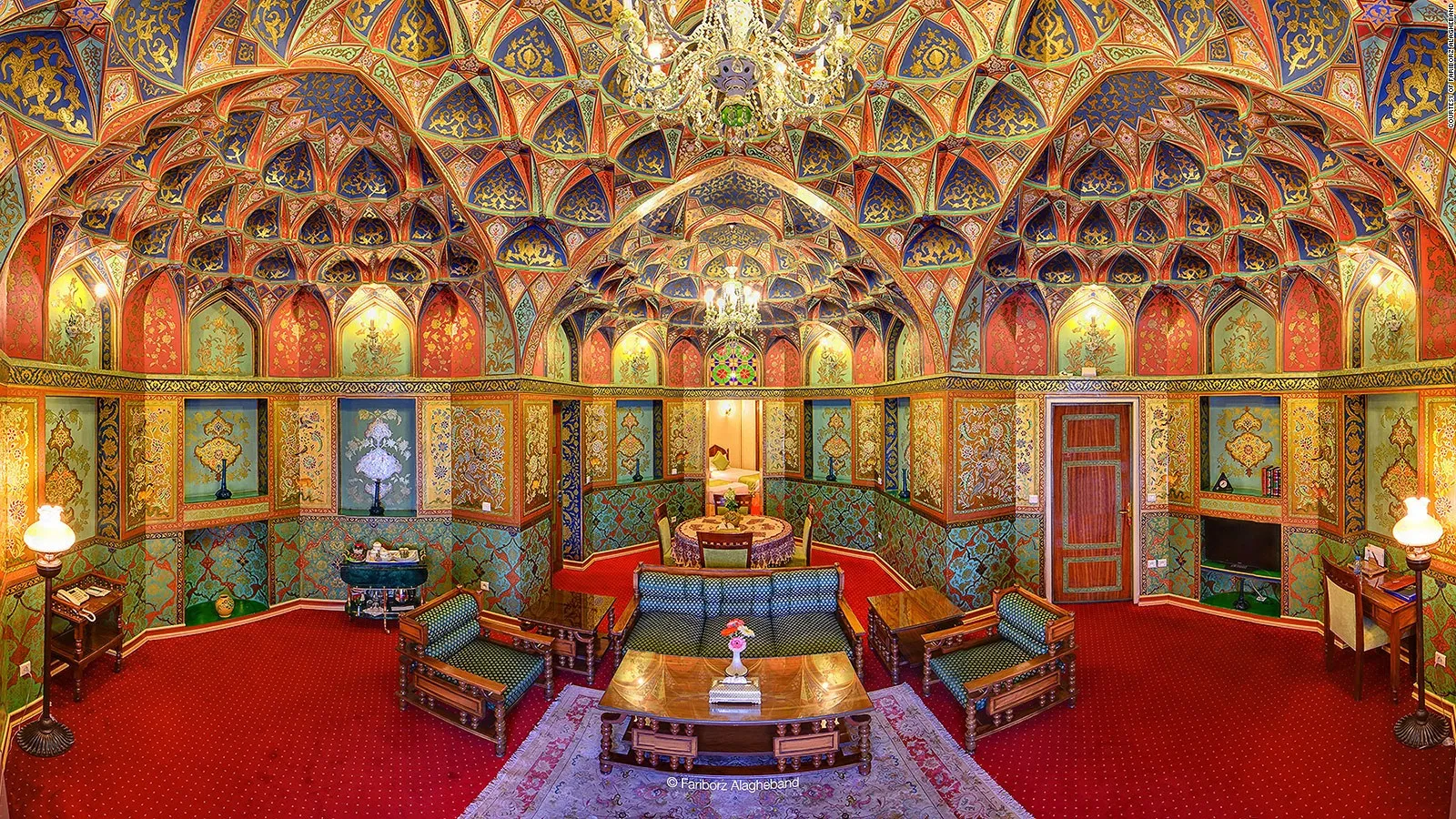When you visit Iran, you’ll find that mosques aren’t just places for prayers. They’re symbols of pride and honor for the people. Built across different cities and eras, these places hold deep artistic and architectural significance. Whether it’s offering prayers or exploring the intricate designs, mosques in Iran are steeped in history and spirituality. From the majestic domes to the intricate tile work, every detail tells a story of craftsmanship and devotion.
For centuries, Iranians have revered the religious sites, seeing them as more than just religious spaces. They’re a testament to the country’s rich cultural heritage and the ingenuity of its people. Even as some mosques have been repurposed as museums, their significance remains unchanged. They continue to inspire awe and reverence, serving as reminders of Iran’s glorious past and enduring faith.
So when you step into a mosque in Iran, remember that you’re not just visiting a religious place. You’re experiencing a piece of history, a symbol of Iranian pride and resilience.
Imam Reza Holy Shrine in Mashhad
If you’re planning a visit to Mashhad, Iran, you can’t miss out on the Imam Reza Shrine, a holy complex steeped in history and spirituality. Imam Reza, a revered figure in Islam, lends his name to this shrine, which has evolved over centuries into a symbol of religious devotion and architectural splendor. From its humble beginnings to its current grandeur, the shrine has attracted Muslims worldwide.
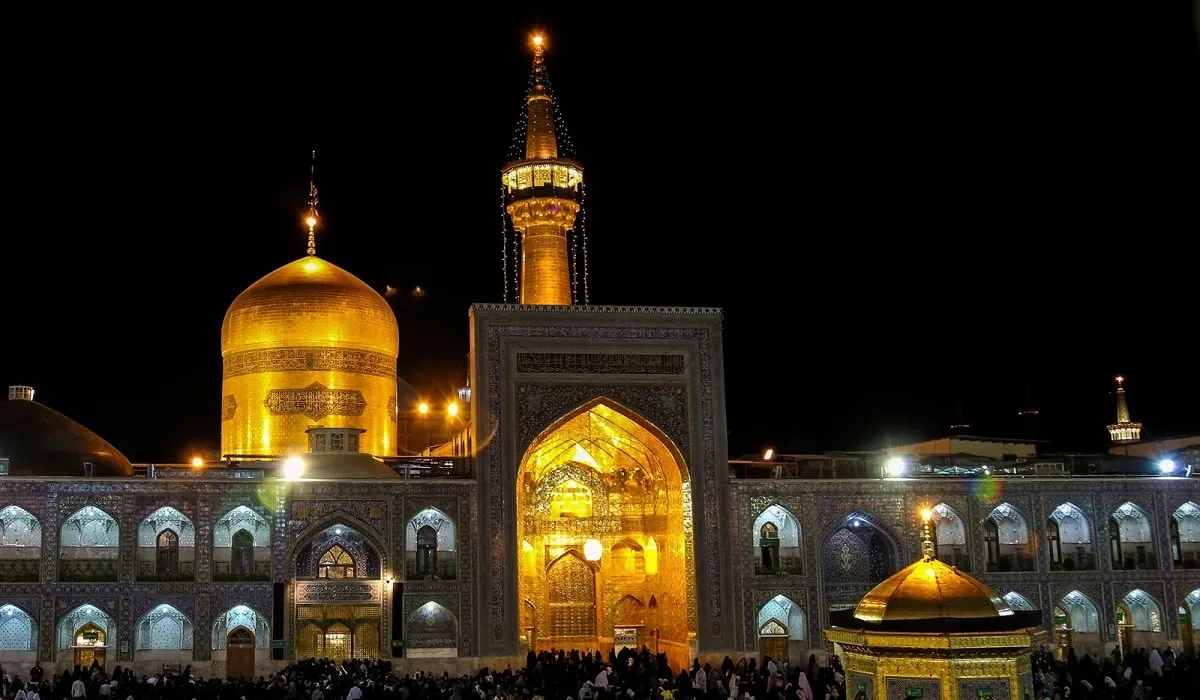

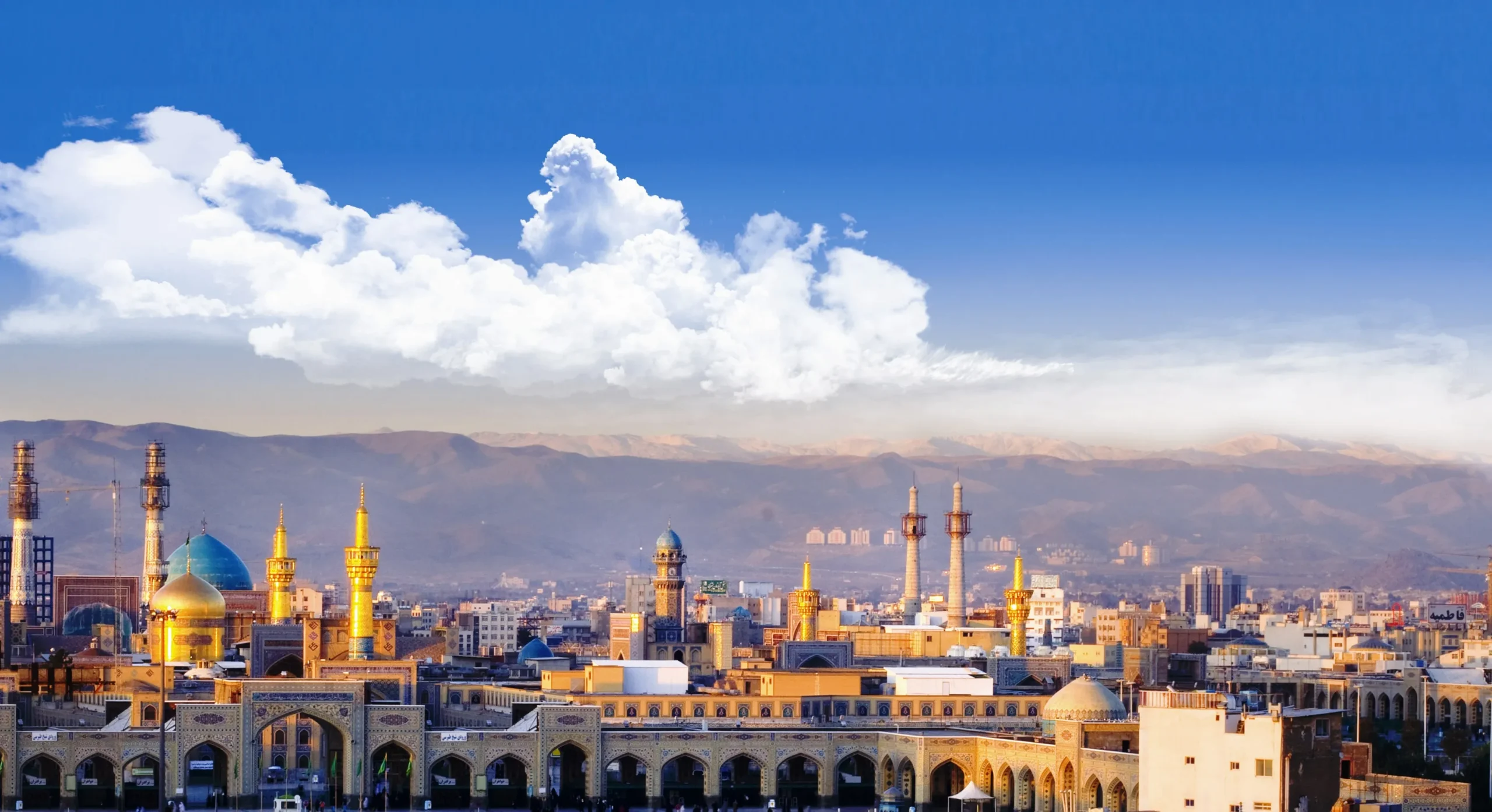
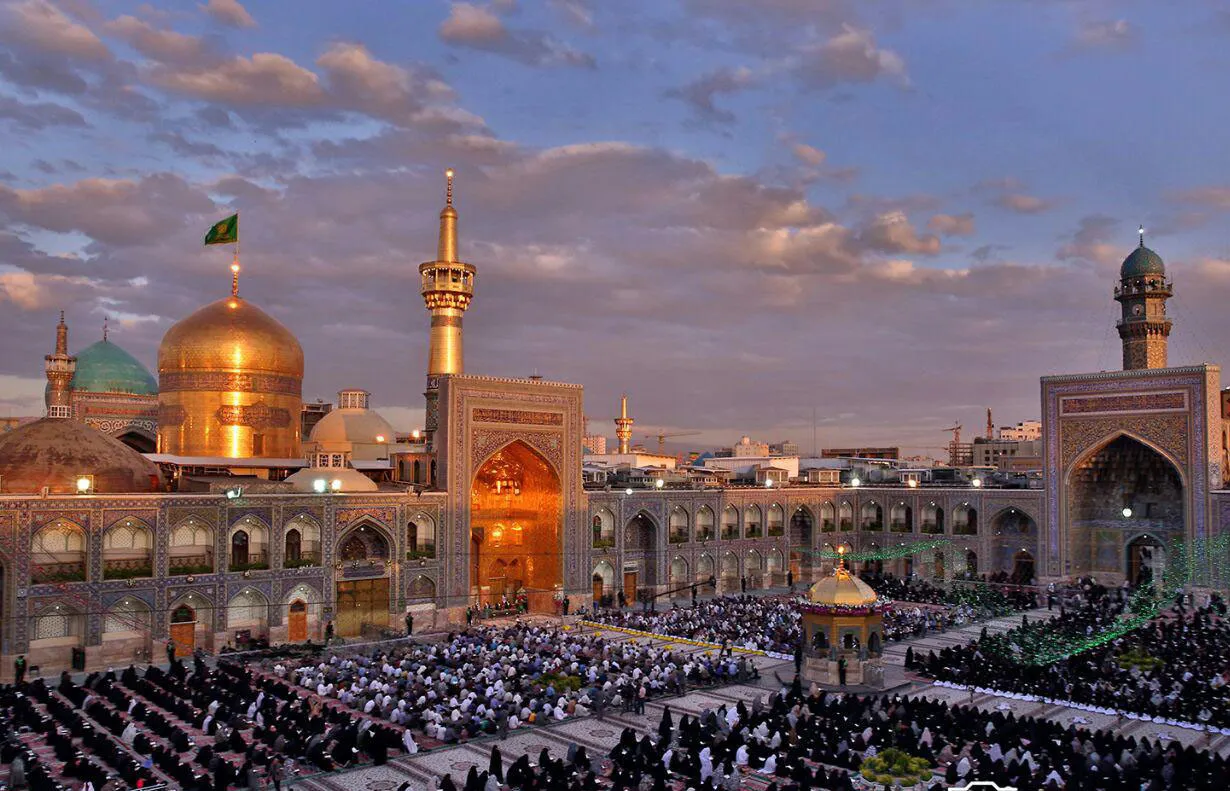
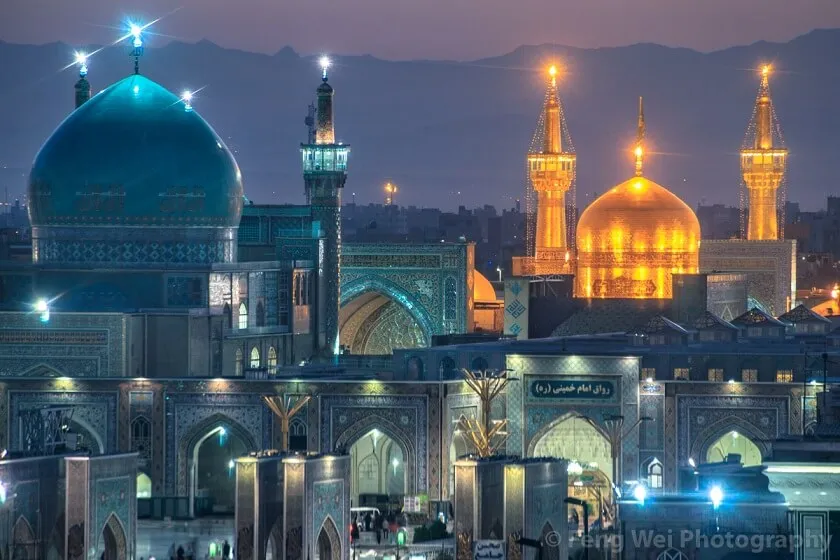
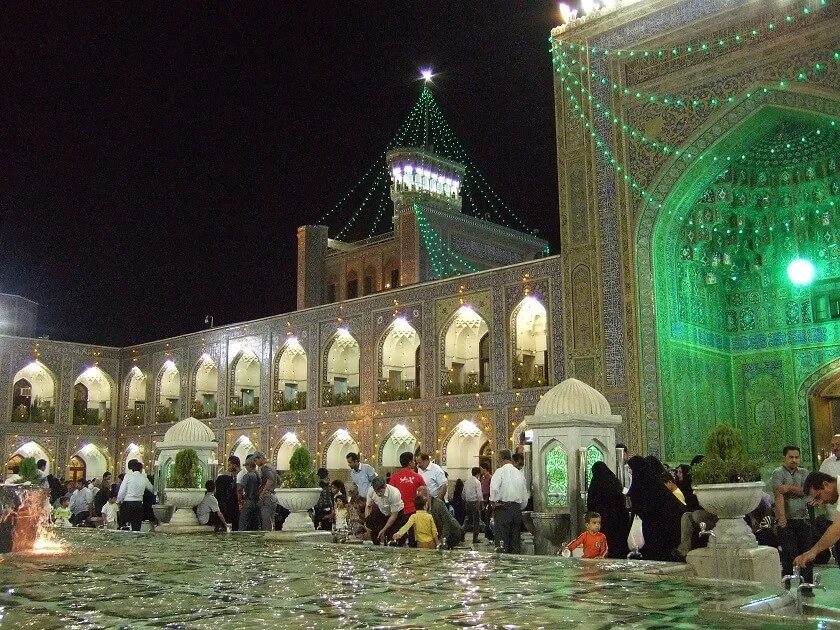
As you step into the Imam Reza Shrine, you’ll be enveloped in a sense of reverence and awe. The complex, adorned with intricate tile work, gilded domes, and towering minarets, stands as a testament to the enduring faith of believers. Throughout history, the shrine has been meticulously maintained and expanded, with each addition reflecting the cultural and religious influences of its time.
One of the most striking aspects of the Imam Reza Shrine is its rich variety of rituals and traditions. From the solemn act of dusting to the stirring melodies of the Naqareh, every ritual is imbued with profound meaning and significance. As you witness these rituals unfold, you’ll gain a deeper understanding of the spiritual essence that permeates the shrine.
Beyond its religious significance, the Imam Reza Shrine holds immense cultural and historical importance. Over the centuries, it has served as a focal point for the development of Mashhad, shaping the city’s identity and urban landscape. From the majestic Goharshad Mosque to the intricate Allah Verdikhan Dome, the architectural marvels within the complex speak to the ingenuity and craftsmanship of generations past. Whether you’re a devout pilgrim or a curious traveler, the shrine offers a profound and unforgettable experience.
Nasir-ol-Molk Mosque in Shiraz
If you find yourself in Shiraz, make sure to visit the mesmerizing Nasir al-Molk Mosque, also known as the Pink Mosque. Located close to the Shah Cheragh Mosque, this architectural gem dates back to the Qajar dynasty and is a true testament to Persian craftsmanship.
Step inside the Nasir al-Molk Mosque, and a breathtaking sight will greet you. The facade of the mosque is adorned with extensive colored glass, casting a kaleidoscope of hues upon the interior as sunlight filters through. One of the most striking features is the Panj Kāse design, characterized by five concaved arches that add to the mosque’s allure.
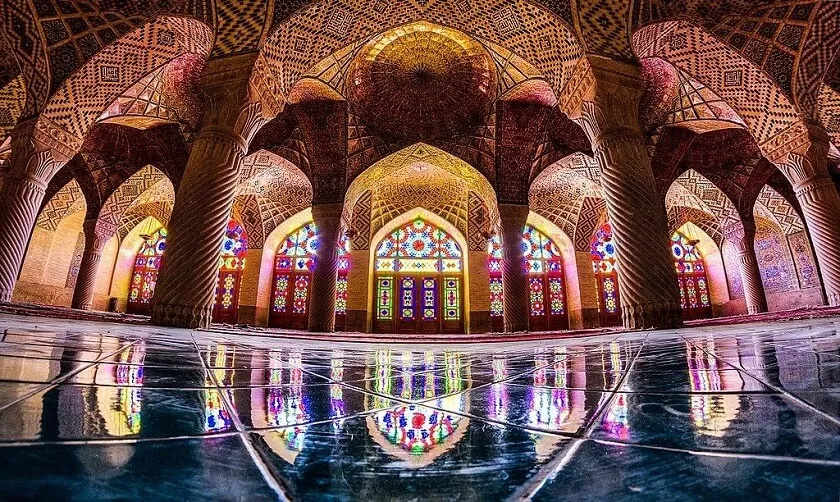
The history of the Nasir al-Molk Mosque is as fascinating as its architecture. Construction began in 1876 under the patronage of Mirza Hassan Ali Nasir-ol-Molk, a prominent figure in Shiraz. Over a decade later, in 1888, the mosque was completed, thanks to the vision of Persian architects such as Mohammad Hasan-e-Memār and Mohammad Hosseini Shirazi.
However, perhaps the most enchanting aspect of the Nasir al-Molk Mosque is its colorful glass windows, known as Orsi. While colorful glass is commonly associated with churches, the roots of this art form can be traced back to Persian traditions. Dating as far back as the 7th century, Persian chemist Jabir ibn Hayyan documented techniques for creating colorful glass in his writings.
The Orsi windows in the Nasir al-Molk Mosque are not just decorative; they serve a deeper purpose. In Islamic tradition, light is a symbol of the divine, and these colorful windows allow sunlight to illuminate the sacred space within the mosque. As you bask in the ethereal glow of the Nasir al-Molk Mosque, you’ll understand why it’s considered one of the most beautiful mosques in the world. So, don’t miss the opportunity to experience this architectural masterpiece firsthand when you visit Shiraz.
Shah-Cheragh Shrine in Shiraz
This magnificent 12th-century funerary monument and religious complex holds deep significance for visitors and locals alike. Named after Sayyid Ahmad, the son of Musa al-Kazim, who is revered as Shah Cheragh (King of the Light), this shrine is a symbol of spiritual devotion and architectural beauty.
The history of the Shah Cheragh Shrine is as captivating as its architecture. Constructed during the rule of the Salghurids in the 13th century, the shrine underwent several expansions and renovations over the centuries. From the contributions of Queen Tash Khatun during the Injuid period to the extensive renovations under Safavid rule, each era left its mark on this sacred site.
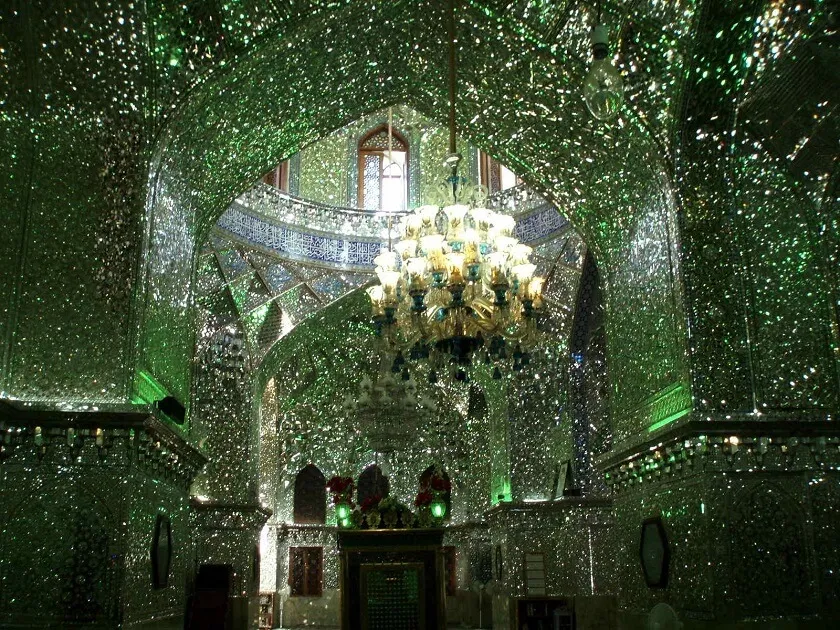
One of the most striking features of the Shah Cheragh Shrine is its stunning architecture. The mausoleum of Sayyid Ahmad, topped by a large dome, is adorned with intricate plaster and stonework. Inside, the dome boasts mesmerizing mirror work and Persian calligraphy, creating a sense of awe and reverence for visitors.
Adjacent to the mausoleum is a mosque, and within the complex lies a museum housing ancient artifacts and manuscripts. The museum offers a glimpse into Iran’s rich cultural heritage, from pottery and clay artwork to coins from the Parthian and Sassanian periods.
As you explore the Shah Cheragh Shrine, you’ll be immersed in a world of history, culture, and spirituality. Whether you’re marveling at its exquisite architecture or reflecting on its tranquil surroundings, this sacred site offers a truly unforgettable experience.
Sheikh Lotfollah Mosque in Isfahan
When the King of Iran, Shah Abbas, shifted the capital to Isfahan during the Safavid Empire, he envisioned creating a city of unparalleled grandeur. To achieve this, his wise minister devised a plan to harness the beauty of Isfahan’s Zayandeh Roud River, known as the Giver of Life. Two remarkable architectural marvels emerged from this vision: Chahar-Bagh Avenue, still bustling after five centuries, and the magnificent Naqsh-e-Jahan Square.
At the eastern edge of Naqsh-e-Jahan Square stands the Sheikh Lotfollah Mosque, a religious gem unlike any other. Strikingly, it lacks the traditional minarets and entry courtyard typical of mosques. This departure from convention serves a dual purpose: firstly, as a private sanctuary for the royal family residing in the nearby Ali-Qapu Palace, and secondly, to preserve the square’s symmetrical harmony.
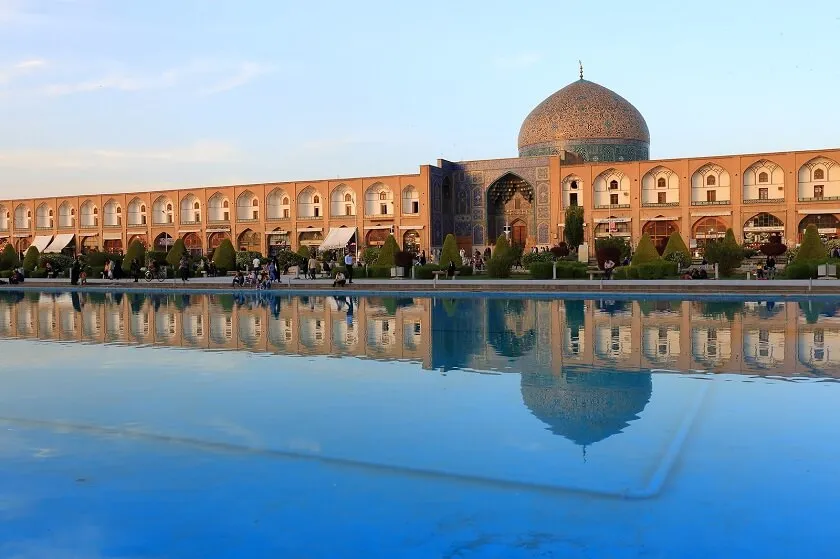

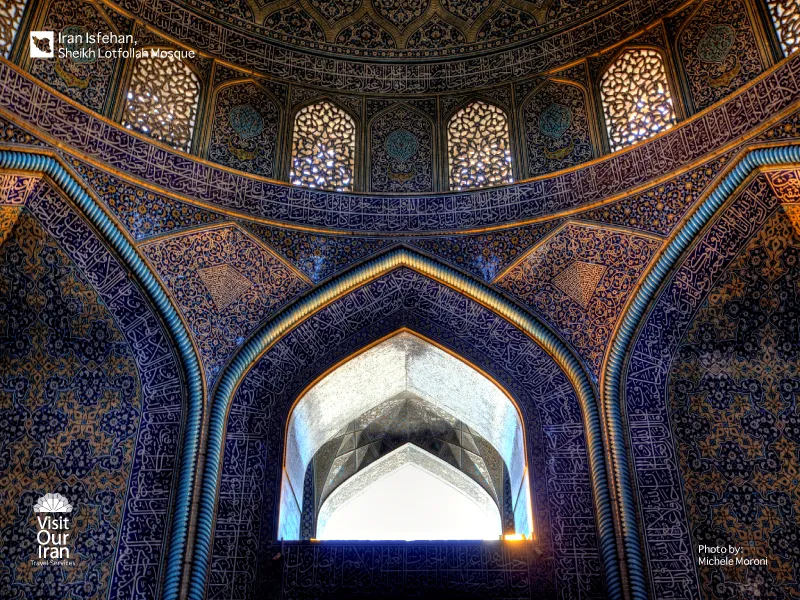
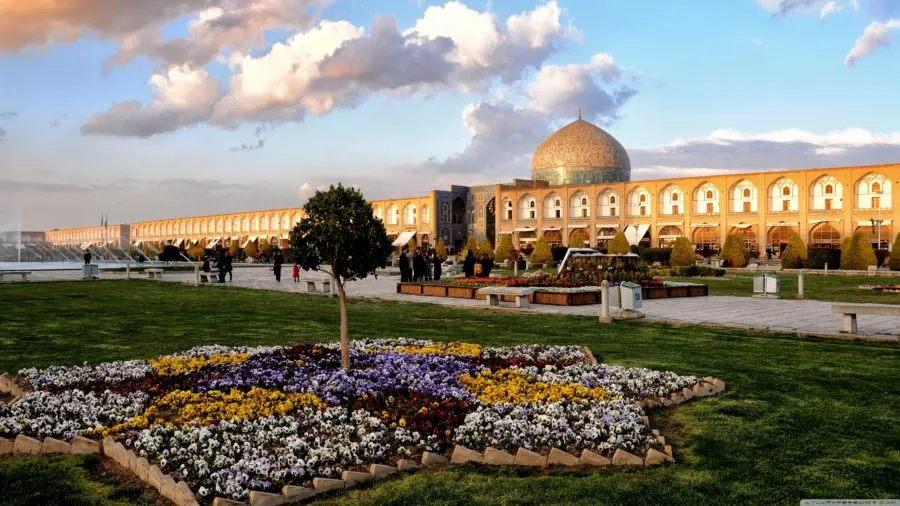
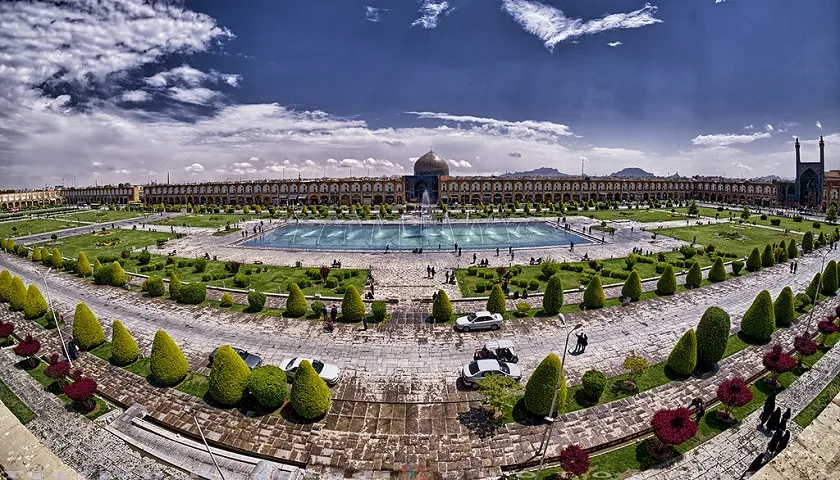
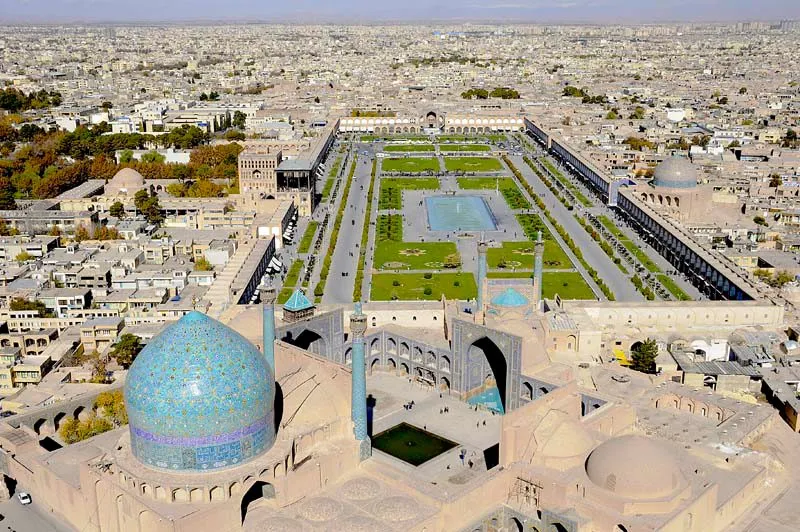
The mosque’s architectural splendor is matched only by its intricate tile work and inscriptions, executed by master craftsmen. The mesmerizing blue tiles, synonymous with Persian artistry, even inspired the design of Persian carpets. Once, a tunnel connected this private mosque to the Ali-Qapu Palace, weaving beneath the square’s gardens, fountains, and pools.
Today, this site stands as a testament to art, history, and spirituality, beckoning travelers to explore its rich tapestry of culture and faith. A visit to Isfahan would be incomplete without experiencing the timeless beauty of the Sheikh Lotfollah Mosque.
Imam Mosque in Isfahan
Imam Mosque, formerly known as Shah Mosque, is a renowned masterpiece of Persian architecture located in the heart of Isfahan, adjacent to Naqsh-e Jahan Square. Built during the Safavid era under Shah Abbas I, it stands as a symbol of Iran’s rich historical and cultural heritage. With its breathtaking blue-tiled mosaics and impeccable proportions, it captivates visitors with its timeless beauty.
Constructed between 1611 and 1630, the Imam Mosque was a tribute to Shah Abbas’s ancestor, Shah Tahmasb, intended to honor his soul. The mosque’s construction involved notable figures such as Badi’ al-Zaman Tuni, ‘Ali Akbar Isfahani, and Muhibb ‘Ali Beg, as recorded in inscriptions on the building.
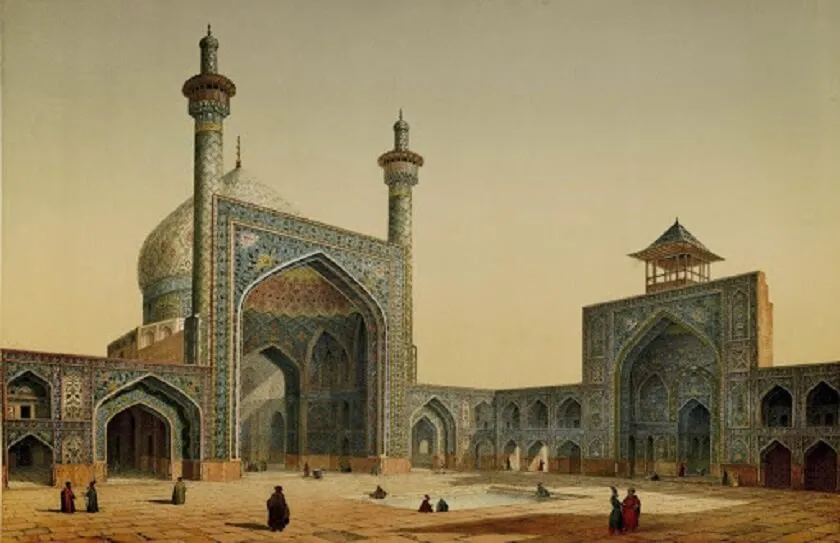
This architectural marvel consists of two main structures: a magnificent entrance gate adorned with minarets and the mosque’s main building featuring a grand dome. The entrance, designed in the distinctive iwan style, reflects the Islamic architectural influence of the Seljuk and Safavid dynasties.
An intriguing aspect of Imam Mosque is its unique orientation. While most buildings faced Mecca, the mosque’s entrance leads in a different direction. However, upon entering, a slight turn to the right aligns visitors with the direction of Mecca, ensuring both structures remain visible from the square.
The mosque’s interior is adorned with seven-colored wall tiles, creating mesmerizing mosaic patterns and calligraphy. Notably, its acoustic properties are remarkable, allowing sounds to echo clearly throughout the building. A strategically placed stone under the central dome enhances this effect, enabling the imam’s voice to reach every corner of the mosque.
Imam Mosque’s significance extends beyond its architectural grandeur; it serves as a testament to Iran’s artistic and spiritual legacy. As you explore its sacred halls and marvel at its beauty, you’ll be immersed in the rich history and culture of Isfahan.
Agha Bozorg Mosque in Kashan
When you visit the city of Kashan, known as the mosque city of Iran, you’ll encounter a treasure trove of beautifully crafted mosques, each with its own unique history and significance. One such gem is the Agha Bozorg Mosque, nestled in the historic heart of Kashan.
This mosque holds a special place in Kashan’s history, named after the revered theologian and teacher, Mulla Mohammad Naraghi, who earned the title Agha Bozorg, meaning the Great Master, bestowed upon him by King Fathali Shah Qajar. Built as a place of worship and learning, the mosque stands as a testament to Agha Bozorg’s legacy.
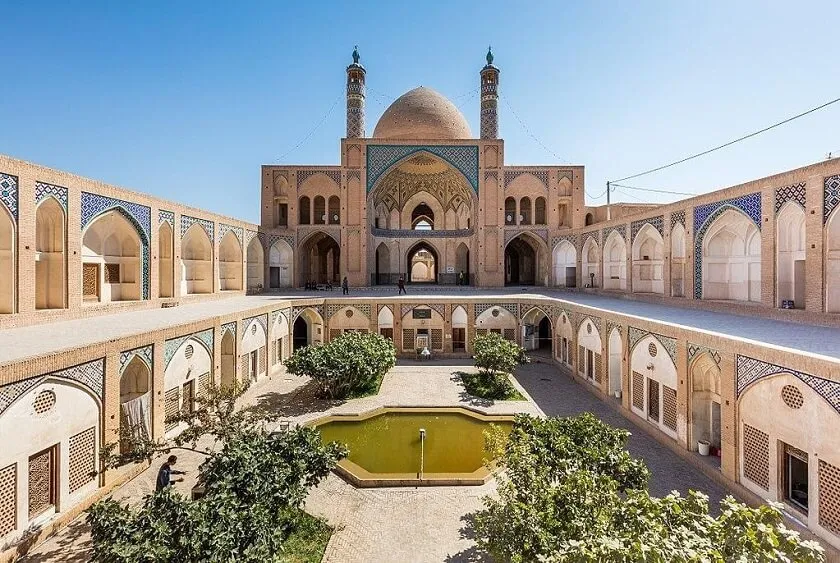
The architectural marvel of the Agha Bozorg Mosque is evident in its unique design, tailored to suit the warm climate of Kashan and minimize the need for excessive labor during construction. The symmetrical layout and grand iwans showcase the ingenuity of its builders, reflecting architectural mastery.
A notable feature of this mosque is its integration with a school, seamlessly blending education and prayer within its walls. The harmonious coexistence of these two institutions adds to the mosque’s allure and architectural significance.
Like many mosques in desert regions of Iran, the Agha Bozorg Mosque features a central courtyard adorned with a garden and fountain, providing a tranquil oasis amidst the bustling city. The mosque’s imposing dome, flanked by two intricately tiled minarets, commands attention and reverence.
Inside, the mosque’s interior is adorned with skylights and religious verses, creating a serene atmosphere conducive to prayer and reflection. The ornate tile work adorning the porches reflects the rich artistic heritage of the region, while the library and tombs of trustees offer glimpses into the mosque’s storied past.
Constructed in 1268 AH, the Agha Bozorg Mosque stands as a testament to Kashan’s rich cultural legacy and architectural prowess. As you explore its sacred halls and tranquil courtyards, you’ll be transported back in time, experiencing the beauty and spirituality of this historic site.
Imamzadeh Saleh Shrine in Tehran
When you find yourself in the northern district of Shemiranat, located within the bustling city of Tehran, take a moment to discover the revered Imamzadeh Saleh Shrine, a cherished holy site that holds deep significance for Iranians.
As you wander through the district, you’ll notice the abundance of plane trees that dot the landscape, their majestic presence casting shade and providing a sense of tranquility. Among these trees, there once stood a remarkable plane tree at the heart of the Imamzadeh Saleh courtyard, a symbol of sacredness and divine presence. Though the tree has long since vanished, its memory lives on, cherished by those who once sought solace beneath its branches.
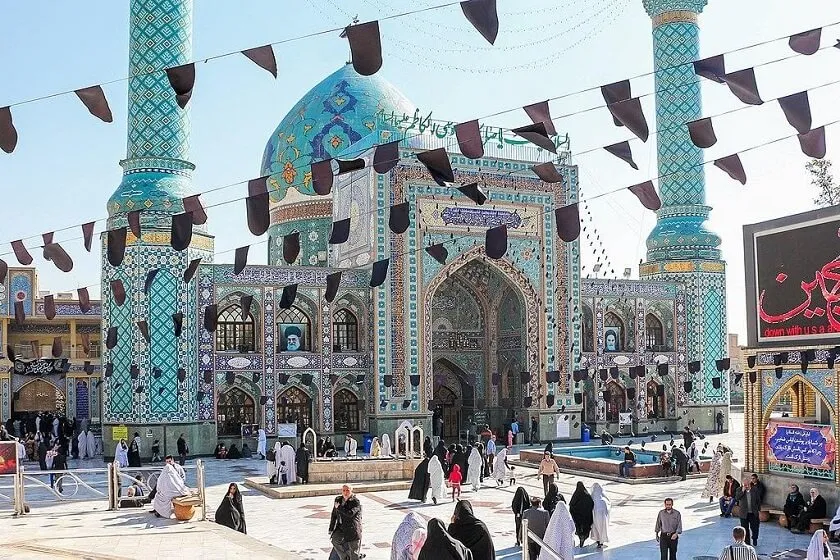
Stepping into the Imamzadeh Saleh Shrine, you’ll be greeted by thick marble walls and ceilings adorned with intricate designs that speak to centuries of reverence and devotion. Bathed in a soft, green light, the shrine exudes an aura of peace and spirituality, inviting visitors to reflect and pay their respects.
At the heart of the shrine lies the tomb of a revered holy figure, revered by Shia Muslims, whose remains are believed to rest within a wooden box dating back to the Safavid or Afghanid era, nearly 400 years ago. It’s a place of pilgrimage and prayer, where believers come to seek blessings and offer tokens of gratitude.
As you explore the shrine, you may encounter pilgrims offering gifts of food, such as bread with cheese and green vegetables, as symbols of their appreciation and devotion. These humble offerings serve as a reminder of the deep spiritual connection shared by those who visit the Imamzadeh Saleh Shrine, a place where faith and tradition converge in harmony.
Whether you’re seeking solace, spiritual enlightenment, or simply a moment of quiet reflection, the Imamzadeh Saleh Shrine offers a sanctuary amidst the bustling cityscape of Tehran. As you immerse yourself in its sacred atmosphere, you’ll discover a profound sense of peace and reverence that transcends time and space, leaving an indelible mark on your soul.
Shah Abdol-Azim Shrine in Tehran
Shah Abdol-Azim Shrine is just a short distance from the busy downtown in Tehran. Here, you’ll encounter the final resting place of ‘Abdul ‘Adhim ibn ‘Abdillah al-Hasani, also known as Shah Abdol Azim, a revered figure with deep roots in Islamic history.
Legend has it that Shah Abdol Azim, a descendant of Hasan ibn ‘Ali and a companion of Muhammad al-Taqi, sought refuge in Rey to escape persecution, ultimately finding his eternal resting place within the shrine’s hallowed grounds. His tomb, dating back to the 9th century, serves as a poignant reminder of his enduring legacy and spiritual significance.
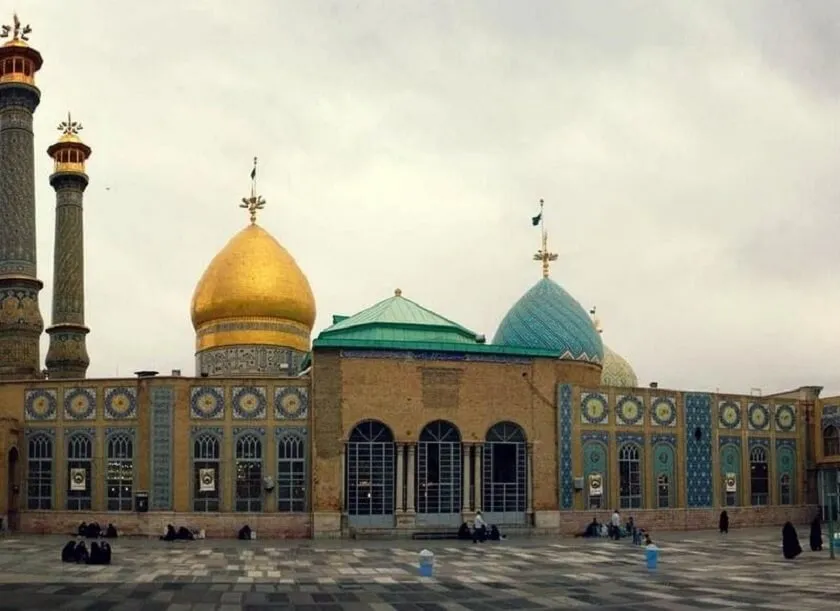
As you explore the shrine complex, you’ll encounter not only the tomb of Shah Abdol Azim but also the mausolea of Imamzadeh Tahir and Imamzadeh Hamzeh, adding to the site’s rich historical tapestry. These sacred spaces, steeped in centuries of reverence and devotion, offer visitors a glimpse into Iran’s storied past and its profound religious heritage.
The Shah Abdol-Azim Shrine has long been a place of pilgrimage and spiritual contemplation, drawing visitors from near and far to pay their respects and seek blessings. Ibn Qulawayh al-Qummi, in his Kamil al-Ziyarat, recognized the shrine’s significance as early as the tenth century, attesting to its enduring allure and importance within the Shia community.
Throughout history, the shrine has received patronage from Sunni rulers, underscoring its universal appeal and significance beyond sectarian divides. Notable among these patrons was Majd al-Mulk As’ad b. Muḥammad b. Musa, the Seljuk vizier who commissioned the construction of a mausoleum over Shah Abdol Azim’s tomb in the 1090s CE, further solidifying the shrine’s status as a revered religious site.
As you step inside the shrine, you’ll be greeted by the majestic iwan portal adorned with intricate Tulth calligraphy, a testament to the exquisite craftsmanship and architectural splendor of the site. Here, amid the tranquil ambiance and sacred atmosphere, you’ll feel a profound sense of reverence and awe, connecting with centuries of devotion and spirituality.
Goharshad Mosque in Mashhad
Goharshad Mosque represents the Timurid architecture located within the Imam Reza shrine complex. This grand congregational mosque, commissioned by Empress Goharshad in 1418 CE, stands as a symbol of spiritual devotion and artistic splendor.
The mosque bears witness to centuries of tumultuous events, including the devastation wrought by the Russian bombings in 1911. The iconic double-layered dome, once a symbol of architectural brilliance, fell victim to the ravages of time and conflict, necessitating extensive restoration efforts in the 1960s. While the repairs were essential for preserving the mosque’s structural integrity, they also altered its historic character irreversibly.
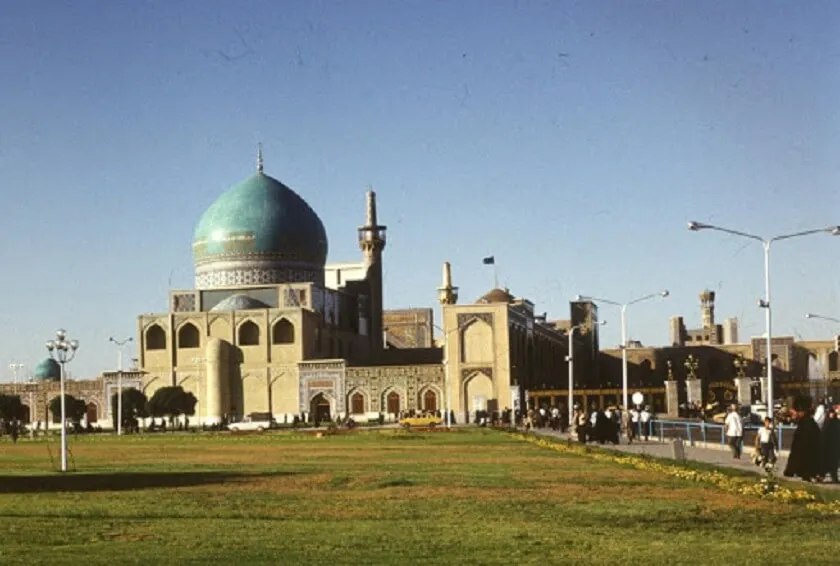
Arthur Pope, a renowned scholar of Persian architecture, hailed the mosque as a masterpiece of the fifteenth century, with its exquisite portal adorned in Samarkand style arches and intricate detailing. The towering minarets, seamlessly merging with the portal screen, exude a sense of solidity and grandeur, while the facade dazzles with enamel brickwork and mosaic faience of unparalleled craftsmanship.
As you step into the mosque’s sacred precincts, you’ll be enveloped in a sense of tranquility and reverence, surrounded by the echoes of centuries-old prayers and devotion. The spiritual resonance of Goharshad Mosque transcends time and space, inviting visitors to reflect on the enduring legacy of faith and artistry.
Explore Religion and Art in the Beauty of Mosques
As you conclude your journey through the mosques of Iran, you can’t help but feel a profound sense of awe and wonder. Each mosque tells a story, not just of architectural marvels but of centuries of faith, culture, and history.
From the majestic domes of Isfahan to the serene courtyards of Tehran, you’ve witnessed the diverse beauty of Islamic architecture. You’ve marveled at the intricate tilework, the graceful arches, and the towering minarets that adorn these sacred spaces.
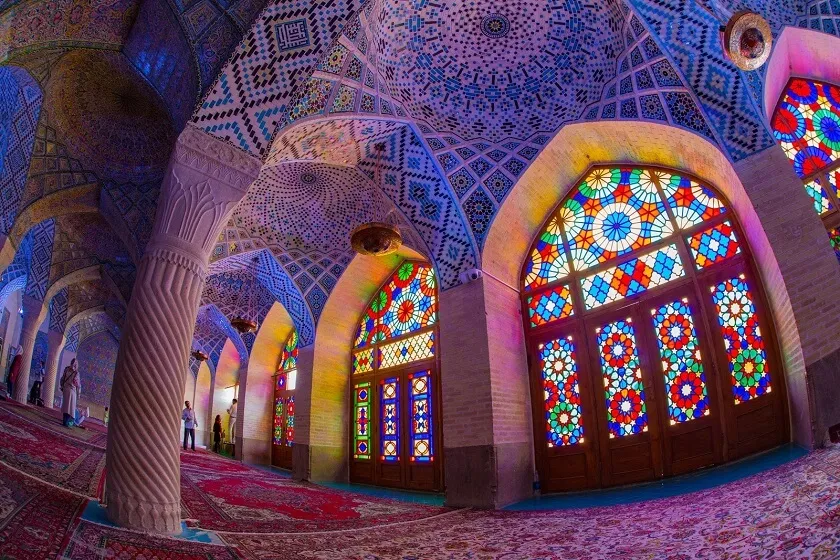
But beyond their architectural splendor, these mosques are vibrant hubs of community life. You’ve seen worshippers gather for prayers, exchange greetings, and share moments of reflection and connection. In these hallowed halls, you’ve felt the universal language of spirituality unite people from all walks of life.
As you bid farewell to Iran’s mosques, you carry with you not just memories but a deeper understanding of the rich cultural tapestry of this ancient land. You’ve glimpsed the soul of Iran, embodied in the silent whispers of prayer and the timeless beauty of its sacred architecture.
So, as you continue your travels, may the spirit of these mosques linger in your heart, reminding you of the enduring power of faith, community, and the universal quest for meaning. May you always cherish the memories of your journey through Iran’s mosques, where history, culture, and spirituality converge in perfect harmony.
If you’re interested in exploring more of Iran’s rich heritage and experiencing a spiritual journey, Visit Our Iran offers Ziyarat (pilgrimage) tours that will take you to these sacred sites and beyond. Contact us to plan your unforgettable pilgrimage experience in Iran.
